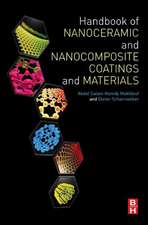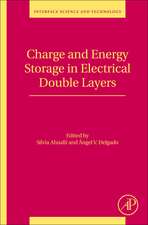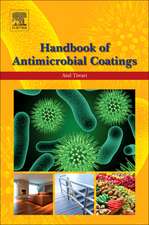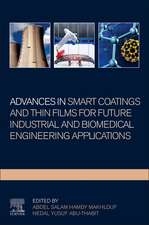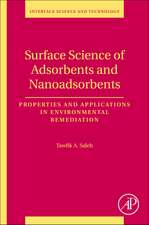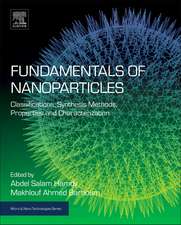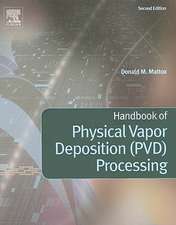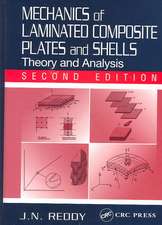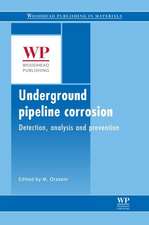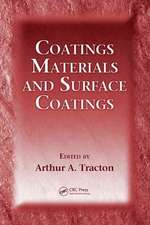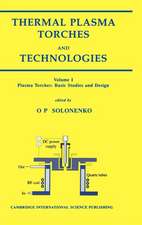Handbook of Smart Coatings for Materials Protection
Editat de Abdel Salam Hamdy Makhloufen Limba Engleză Hardback – 4 feb 2014
Part one explores the fundamentals of smart coatings for materials protection including types, materials, design, and processing. Chapters review corrosion processes and strategies for prevention; smart coatings for corrosion protection; techniques for synthesizing and applying smart coatings; multi-functional, self-healing coatings; and current and future trends of protective coatings for automotive, aerospace, and military applications. Chapters in part two focus on smart coatings with self-healing properties for corrosion protection, including self-healing anticorrosion coatings for structural and petrochemical engineering applications; smart self-healing coatings for corrosion protection of aluminum alloys, magnesium alloys and steel; smart nanocoatings for corrosion detection and control; and recent advances in polyaniline-based organic coatings for corrosion protection. Chapters in part three move on to highlight other types of smart coatings, including smart self-cleaning coatings for corrosion protection; smart polymer nanocomposite water- and oil-repellent coatings for aluminum; UV-curable organic polymer coatings for corrosion protection of steel; smart epoxy coatings for early detection of corrosion in steel and aluminum; and structural ceramics with self-healing properties.
The Handbook of Smart Coatings for Materials Protection is a valuable reference for those concerned with preventing corrosion, particularly of metals, professionals working within the surface coating industries, as well as all those with an academic research interest in the field.
- Reviews the new generation of smart coatings for corrosion and other types of material protection
- Explores the fundamentals of smart coatings for materials protection including types, materials, design, and processing
- Includes a focus on smart coatings with self-healing properties for corrosion protection
Preț: 1281.14 lei
Preț vechi: 1676.08 lei
-24% Nou
Puncte Express: 1922
Preț estimativ în valută:
245.22€ • 266.46$ • 206.12£
245.22€ • 266.46$ • 206.12£
Carte tipărită la comandă
Livrare economică 14-28 aprilie
Preluare comenzi: 021 569.72.76
Specificații
ISBN-13: 9780857096807
ISBN-10: 085709680X
Pagini: 656
Dimensiuni: 156 x 234 x 43 mm
Greutate: 1.07 kg
Editura: ELSEVIER SCIENCE
ISBN-10: 085709680X
Pagini: 656
Dimensiuni: 156 x 234 x 43 mm
Greutate: 1.07 kg
Editura: ELSEVIER SCIENCE
Cuprins
Contributor contact details
Woodhead Publishing Series in Metals and Surface Engineering
Preface
Part I: Fundamentals of smart coatings for materials protection
1. Corrosion processes and strategies for prevention: an introduction
Abstract:
1.1 Introduction
1.2 Corrosion of metals, alloys and composites: an overview
1.3 Wet corrosive environments
1.4 Strategies for corrosion inhibition: design and materials
1.5 Strategies for corrosion inhibition: protective coatings
1.6 Conclusion
1.7 Acknowledgement
1.8 References
2. Smart coatings for corrosion protection: an overview
Abstract:
2.1 Introduction
2.2 Triggering mechanisms
2.3 Self-healing mechanisms
2.4 Sensing systems
2.5 Future trends
2.6 Conclusion
2.7 Acknowledgement
2.8 References
3. Techniques for synthesizing and applying smart coatings for material protection
Abstract:
3.1 Introduction
3.2 Environmentally friendly smart self-healing coatings
3.3 Most common methods and technologies for synthesizing smart coatings
3.4 Conclusion
3.5 References
4. Multi-functional, self-healing coatings for corrosion protection: materials, design and processing
Abstract:
4.1 Introduction
4.2 Key issues in developing multi-functional coatings
4.3 Materials for encapsulation of self-healing and anti-corrosion agents
4.4 Computer-based simulation
4.5 Material testing and function screening
4.6 Processing
4.7 Guiding principles for designing multi-functional coatings
4.8 Case studies and examples
4.9 Conclusion and future trends
4.10 Acknowledgements
4.11 References
5. Strategies for developing multi-functional, self-healing coatings for corrosion prevention and other functions
Abstract:
5.1 Introduction
5.2 Approaches to self-healing of functional coatings
5.3 Corrosion and other functions of coatings recovered or enhanced by self-healing
5.4 Technologies for creating functional self-healing coatings
5.5 Conclusion
5.6 Future trends
5.7 Sources of further information and advice
5.8 References
6. Protective coatings for automotive, aerospace and military applications: current prospects and future trends
Abstract:
6.1 Introduction
6.2 Advances in materials of construction
6.3 Advances in surface pre-treatment
6.4 Advances in top organic coatings
6.5 Optimising the coatings process and testing
6.6 Conclusion and future trends
6.7 References
Part II: Smart coatings with self-healing properties for corrosion protection
7. The use of nano-/microlayers, self-healing and slow-release coatings to prevent corrosion and biofouling
Abstract:
7.1 Introduction
7.2 Corrosion of different metals: mechanisms, monitoring and corrosion inhibitors
7.3 Microbiologically influenced corrosion (MIC) and biofouling: mechanisms, monitoring and control
7.4 Inhibition of corrosion and biofilm formation by nanolayers
7.5 Self-healing coatings against corrosion and biofilm formation with nano-/microcapsules and nano-/microspheres
7.6 Conclusion
7.7 References and further reading
8. Self-healing anti-corrosion coatings for applications in structural and petrochemical engineering
Abstract:
8.1 Introduction
8.2 Self-healing mechanisms
8.3 Self-healing anti-corrosion coatings based on polyaniline (PANI)-modified ferrites
8.4 Self-healing anti-corrosion coatings based on conducting polymer-modified graphene
8.5 Conducting polymer coatings based on PANI-modified TiO2
8.6 Self-healing anti-corrosion coatings using the layer-by-layer approach
8.7 Conclusion and future trends
8.8 References
9. Smart nanocoatings for corrosion detection and control
Abstract:
9.1 Introduction
9.2 Smart anti-corrosion nanocoatings
9.3 Smart self-healing coatings using microcapsules
9.4 Synthesis of microcapsules
9.5 Physical and mechanical properties of self-healing coatings
9.6 Smart nanocoatings for specific applications
9.7 Smart self-cleaning nanocoatings
9.8 Applications of smart nanocoatings
9.9 Conclusion and future trends
9.10 References
10. Smart self-healing coatings for corrosion protection of aluminium alloys
Abstract:
10.1 Introduction
10.2 Corrosion of aluminium alloys
10.3 Conversion coatings with self-healing properties
10.4 Hybrid sol–gel self-healing coatings
10.5 Sol–gel coatings with corrosion inhibitors
10.6 Multilayer coatings combining sol–gel coatings and corrosion inhibitors
10.7 Organic polymeric coatings with self-healing properties
10.8 Smart organic coating systems with controlled inhibitor release
10.9 Smart coatings with micro- and nanocontainers
10.10 Conclusion and future trends
10.11 References
11. Smart stannate-based self-healing coatings for corrosion protection of magnesium alloys
Abstract:
11.1 Introduction
11.2 Developing and testing stannate-based smart coatings
11.3 The performance of stannate-based smart coatings
11.4 Conclusion
11.5 Acknowledgments
11.6 References
12. Incorporating microcapsules in smart coatings for corrosion protection of steel
Abstract:
12.1 Introduction
12.2 Mechanisms of self-healing in smart anticorrosion coatings
12.3 Synthesis of microcapsules
12.4 Characterization of microcapsules
12.5 Testing the effectiveness of coatings
12.6 Conclusion
12.7 Acknowledgments
12.8 References
13. Multi-layer smart coatings for corrosion protection of aluminium alloys and steel
Abstract:
13.1 Introduction
13.2 Developing layer-by-layer (LbL) coatings with active feedback properties
13.3 Methods for formation of LbL coatings
13.4 Case studies
13.5 Conclusion and future trends
13.6 References and further reading
14. Electro-active polymer (EAP) coatings for corrosion protection of metals
Abstract:
14.1 Introduction
14.2 The use of electro-active polymers (EAPs) in corrosion protection
14.3 Synthesis and properties of particular EAPs
14.4 Toxicological properties of poly(2,5-(bis-N-methyl-N-hexylamino) phenylene vinylene (BAM-PPV)
14.5 Methods to evaluate corrosion-inhibiting properties of EAPs
14.6 Corrosion inhibition of ferrous metals using EAP coatings
14.7 Corrosion inhibition of aluminum alloys using EAP coatings
14.8 Future trends
14.9 Conclusion
14.10 Acknowledgment
14.11 References
15. Microencapsulated indicators and inhibitors for corrosion detection and control
Abstract:
15.1 Introduction
15.2 Corrosion indicators and corrosion sensing
15.3 Corrosion inhibitor delivery systems
15.4 Current developments in smart coatings for corrosion sensing and inhibition
15.5 pH-sensitive microcapsules and microparticles
15.6 Microencapsulation methods
15.7 Microcapsules and microparticles for corrosion indication
15.8 Microcapsules and microparticles for corrosion inhibition
15.9 Conclusion
15.10 Acknowledgments
15.10 References
15.12 Appendix: list of acronyms
Part III: Other types of smart coating
16. Smart acrylic coatings containing silica particles for corrosion protection of aluminum and other metals
Abstract:
16.1 Introduction
16.2 The use of acrylic polymers in coatings
16.3 Synthesis and characterization of novel acrylic-based copolymers
16.4 Sol–gel incorporation of silica nanoparticles
16.5 Analyzing crosslinking and key properties in the coating
16.6 Conclusion
16.7 Acknowledgments
16.8 References
17. Recent advances in polyaniline (PANI)-based organic coatings for corrosion protection
Abstract:
17.1 Introduction
17.2 Polyaniline (PANI) as an intrinsically conductive polymer (ICP)
17.3 PANI as an anti-corrosion polymer
17.4 Mechanisms of PANI as a barrier protective coating
17.5 Mechanism of PANI as a corrosion inhibitor
17.6 Mechanism of PANI in self-healing coatings with controlled inhibitor release
17.7 Conclusion and future trends
17.8 References
18. Smart self-cleaning coatings for corrosion protection
Abstract:
18.1 Introduction
18.2 Types of self-cleaning coatings
18.3 Techniques for developing self-cleaning coatings
18.4 TiO2 as a material for corrosion protection
18.5 Conclusion
18.6 Future trends
18.7 References
19. Smart polymer nanocomposite water and oil repellent coatings for aluminum
Abstract:
19.1 Introduction
19.2 Developing super-hydrophobic coatings: materials, processing and characterization
19.3 Flame treatment for super-hydrophobicity
19.4 Assessing coating properties
19.5 Electrical characteristics of the super-hydrophobic coatings
19.6 Conclusion
19.7 References
20. UV-curable organic polymer coatings for corrosion protection of steel
Abstract:
20.1 Introduction
20.2 UV-cured coatings: materials and mechanisms of crosslinking
20.3 Additives and pigments
20.4 Case studies
20.5 Conclusion
20.6 Sources of further information and advice
20.7 References
21. Smart epoxy coatings for early detection of corrosion in steel and aluminum
Abstract:
21.1 Introduction
21.2 In situ early corrosion detection via indicator molecules embedded in a protective coating
21.3 Early detection of steel corrosion via ‘turn-on’ fluorescence
21.4 Sensing mechanism of the corrosion indicator
21.5 Early detection of aluminum corrosion via ‘turn-on’ fluorescence
21.6 Future trends
21.7 Conclusion
21.8 References
22. Structural ceramics with self-healing properties
Abstract:
22.1 Introduction
22.2 Material development
22.3 Self-crack-healing behavior
22.4 High-temperature strength of crack-healed specimen
22.5 Crack-healing behavior during service
22.6 Conclusion
22.7 References
Index
Woodhead Publishing Series in Metals and Surface Engineering
Preface
Part I: Fundamentals of smart coatings for materials protection
1. Corrosion processes and strategies for prevention: an introduction
Abstract:
1.1 Introduction
1.2 Corrosion of metals, alloys and composites: an overview
1.3 Wet corrosive environments
1.4 Strategies for corrosion inhibition: design and materials
1.5 Strategies for corrosion inhibition: protective coatings
1.6 Conclusion
1.7 Acknowledgement
1.8 References
2. Smart coatings for corrosion protection: an overview
Abstract:
2.1 Introduction
2.2 Triggering mechanisms
2.3 Self-healing mechanisms
2.4 Sensing systems
2.5 Future trends
2.6 Conclusion
2.7 Acknowledgement
2.8 References
3. Techniques for synthesizing and applying smart coatings for material protection
Abstract:
3.1 Introduction
3.2 Environmentally friendly smart self-healing coatings
3.3 Most common methods and technologies for synthesizing smart coatings
3.4 Conclusion
3.5 References
4. Multi-functional, self-healing coatings for corrosion protection: materials, design and processing
Abstract:
4.1 Introduction
4.2 Key issues in developing multi-functional coatings
4.3 Materials for encapsulation of self-healing and anti-corrosion agents
4.4 Computer-based simulation
4.5 Material testing and function screening
4.6 Processing
4.7 Guiding principles for designing multi-functional coatings
4.8 Case studies and examples
4.9 Conclusion and future trends
4.10 Acknowledgements
4.11 References
5. Strategies for developing multi-functional, self-healing coatings for corrosion prevention and other functions
Abstract:
5.1 Introduction
5.2 Approaches to self-healing of functional coatings
5.3 Corrosion and other functions of coatings recovered or enhanced by self-healing
5.4 Technologies for creating functional self-healing coatings
5.5 Conclusion
5.6 Future trends
5.7 Sources of further information and advice
5.8 References
6. Protective coatings for automotive, aerospace and military applications: current prospects and future trends
Abstract:
6.1 Introduction
6.2 Advances in materials of construction
6.3 Advances in surface pre-treatment
6.4 Advances in top organic coatings
6.5 Optimising the coatings process and testing
6.6 Conclusion and future trends
6.7 References
Part II: Smart coatings with self-healing properties for corrosion protection
7. The use of nano-/microlayers, self-healing and slow-release coatings to prevent corrosion and biofouling
Abstract:
7.1 Introduction
7.2 Corrosion of different metals: mechanisms, monitoring and corrosion inhibitors
7.3 Microbiologically influenced corrosion (MIC) and biofouling: mechanisms, monitoring and control
7.4 Inhibition of corrosion and biofilm formation by nanolayers
7.5 Self-healing coatings against corrosion and biofilm formation with nano-/microcapsules and nano-/microspheres
7.6 Conclusion
7.7 References and further reading
8. Self-healing anti-corrosion coatings for applications in structural and petrochemical engineering
Abstract:
8.1 Introduction
8.2 Self-healing mechanisms
8.3 Self-healing anti-corrosion coatings based on polyaniline (PANI)-modified ferrites
8.4 Self-healing anti-corrosion coatings based on conducting polymer-modified graphene
8.5 Conducting polymer coatings based on PANI-modified TiO2
8.6 Self-healing anti-corrosion coatings using the layer-by-layer approach
8.7 Conclusion and future trends
8.8 References
9. Smart nanocoatings for corrosion detection and control
Abstract:
9.1 Introduction
9.2 Smart anti-corrosion nanocoatings
9.3 Smart self-healing coatings using microcapsules
9.4 Synthesis of microcapsules
9.5 Physical and mechanical properties of self-healing coatings
9.6 Smart nanocoatings for specific applications
9.7 Smart self-cleaning nanocoatings
9.8 Applications of smart nanocoatings
9.9 Conclusion and future trends
9.10 References
10. Smart self-healing coatings for corrosion protection of aluminium alloys
Abstract:
10.1 Introduction
10.2 Corrosion of aluminium alloys
10.3 Conversion coatings with self-healing properties
10.4 Hybrid sol–gel self-healing coatings
10.5 Sol–gel coatings with corrosion inhibitors
10.6 Multilayer coatings combining sol–gel coatings and corrosion inhibitors
10.7 Organic polymeric coatings with self-healing properties
10.8 Smart organic coating systems with controlled inhibitor release
10.9 Smart coatings with micro- and nanocontainers
10.10 Conclusion and future trends
10.11 References
11. Smart stannate-based self-healing coatings for corrosion protection of magnesium alloys
Abstract:
11.1 Introduction
11.2 Developing and testing stannate-based smart coatings
11.3 The performance of stannate-based smart coatings
11.4 Conclusion
11.5 Acknowledgments
11.6 References
12. Incorporating microcapsules in smart coatings for corrosion protection of steel
Abstract:
12.1 Introduction
12.2 Mechanisms of self-healing in smart anticorrosion coatings
12.3 Synthesis of microcapsules
12.4 Characterization of microcapsules
12.5 Testing the effectiveness of coatings
12.6 Conclusion
12.7 Acknowledgments
12.8 References
13. Multi-layer smart coatings for corrosion protection of aluminium alloys and steel
Abstract:
13.1 Introduction
13.2 Developing layer-by-layer (LbL) coatings with active feedback properties
13.3 Methods for formation of LbL coatings
13.4 Case studies
13.5 Conclusion and future trends
13.6 References and further reading
14. Electro-active polymer (EAP) coatings for corrosion protection of metals
Abstract:
14.1 Introduction
14.2 The use of electro-active polymers (EAPs) in corrosion protection
14.3 Synthesis and properties of particular EAPs
14.4 Toxicological properties of poly(2,5-(bis-N-methyl-N-hexylamino) phenylene vinylene (BAM-PPV)
14.5 Methods to evaluate corrosion-inhibiting properties of EAPs
14.6 Corrosion inhibition of ferrous metals using EAP coatings
14.7 Corrosion inhibition of aluminum alloys using EAP coatings
14.8 Future trends
14.9 Conclusion
14.10 Acknowledgment
14.11 References
15. Microencapsulated indicators and inhibitors for corrosion detection and control
Abstract:
15.1 Introduction
15.2 Corrosion indicators and corrosion sensing
15.3 Corrosion inhibitor delivery systems
15.4 Current developments in smart coatings for corrosion sensing and inhibition
15.5 pH-sensitive microcapsules and microparticles
15.6 Microencapsulation methods
15.7 Microcapsules and microparticles for corrosion indication
15.8 Microcapsules and microparticles for corrosion inhibition
15.9 Conclusion
15.10 Acknowledgments
15.10 References
15.12 Appendix: list of acronyms
Part III: Other types of smart coating
16. Smart acrylic coatings containing silica particles for corrosion protection of aluminum and other metals
Abstract:
16.1 Introduction
16.2 The use of acrylic polymers in coatings
16.3 Synthesis and characterization of novel acrylic-based copolymers
16.4 Sol–gel incorporation of silica nanoparticles
16.5 Analyzing crosslinking and key properties in the coating
16.6 Conclusion
16.7 Acknowledgments
16.8 References
17. Recent advances in polyaniline (PANI)-based organic coatings for corrosion protection
Abstract:
17.1 Introduction
17.2 Polyaniline (PANI) as an intrinsically conductive polymer (ICP)
17.3 PANI as an anti-corrosion polymer
17.4 Mechanisms of PANI as a barrier protective coating
17.5 Mechanism of PANI as a corrosion inhibitor
17.6 Mechanism of PANI in self-healing coatings with controlled inhibitor release
17.7 Conclusion and future trends
17.8 References
18. Smart self-cleaning coatings for corrosion protection
Abstract:
18.1 Introduction
18.2 Types of self-cleaning coatings
18.3 Techniques for developing self-cleaning coatings
18.4 TiO2 as a material for corrosion protection
18.5 Conclusion
18.6 Future trends
18.7 References
19. Smart polymer nanocomposite water and oil repellent coatings for aluminum
Abstract:
19.1 Introduction
19.2 Developing super-hydrophobic coatings: materials, processing and characterization
19.3 Flame treatment for super-hydrophobicity
19.4 Assessing coating properties
19.5 Electrical characteristics of the super-hydrophobic coatings
19.6 Conclusion
19.7 References
20. UV-curable organic polymer coatings for corrosion protection of steel
Abstract:
20.1 Introduction
20.2 UV-cured coatings: materials and mechanisms of crosslinking
20.3 Additives and pigments
20.4 Case studies
20.5 Conclusion
20.6 Sources of further information and advice
20.7 References
21. Smart epoxy coatings for early detection of corrosion in steel and aluminum
Abstract:
21.1 Introduction
21.2 In situ early corrosion detection via indicator molecules embedded in a protective coating
21.3 Early detection of steel corrosion via ‘turn-on’ fluorescence
21.4 Sensing mechanism of the corrosion indicator
21.5 Early detection of aluminum corrosion via ‘turn-on’ fluorescence
21.6 Future trends
21.7 Conclusion
21.8 References
22. Structural ceramics with self-healing properties
Abstract:
22.1 Introduction
22.2 Material development
22.3 Self-crack-healing behavior
22.4 High-temperature strength of crack-healed specimen
22.5 Crack-healing behavior during service
22.6 Conclusion
22.7 References
Index

